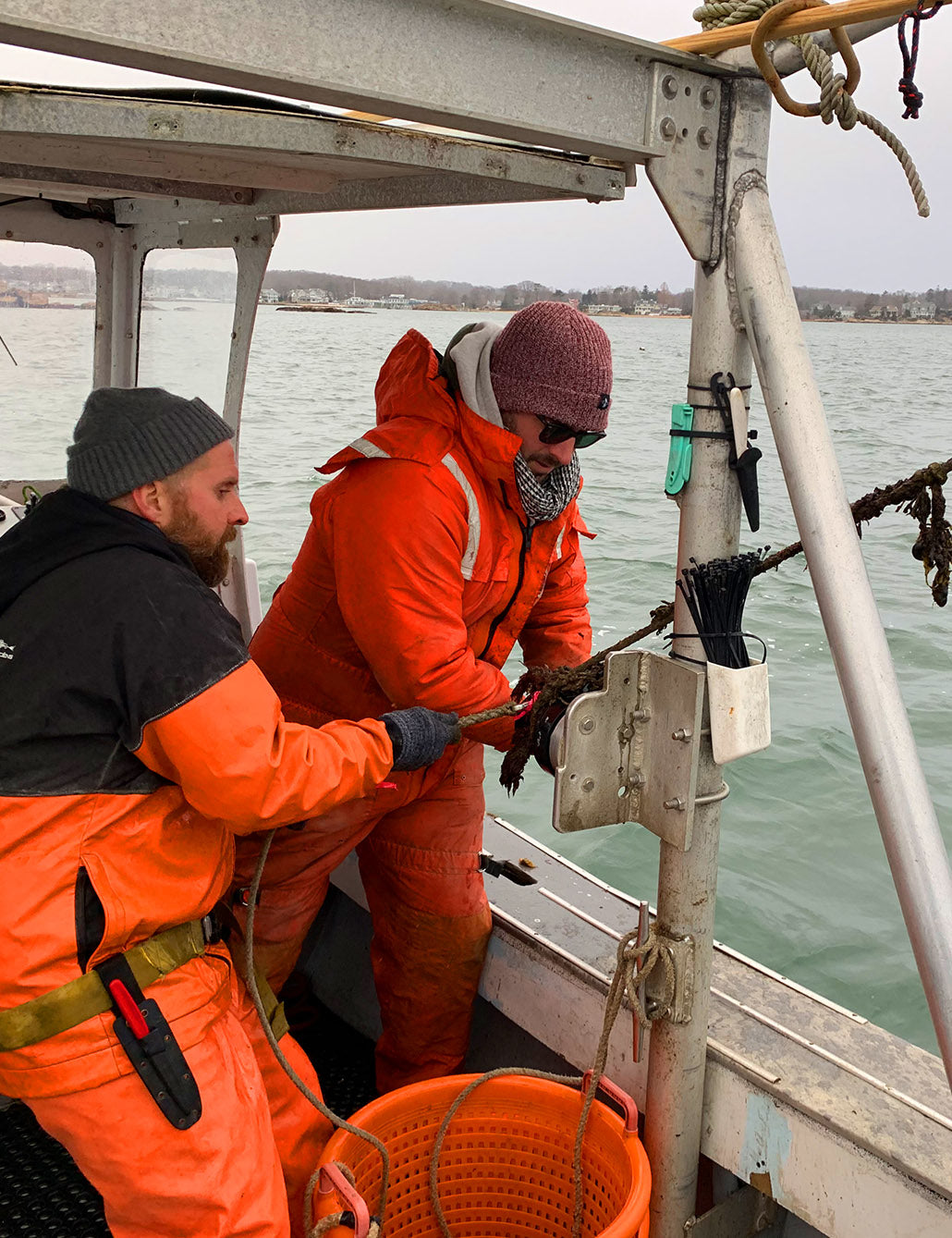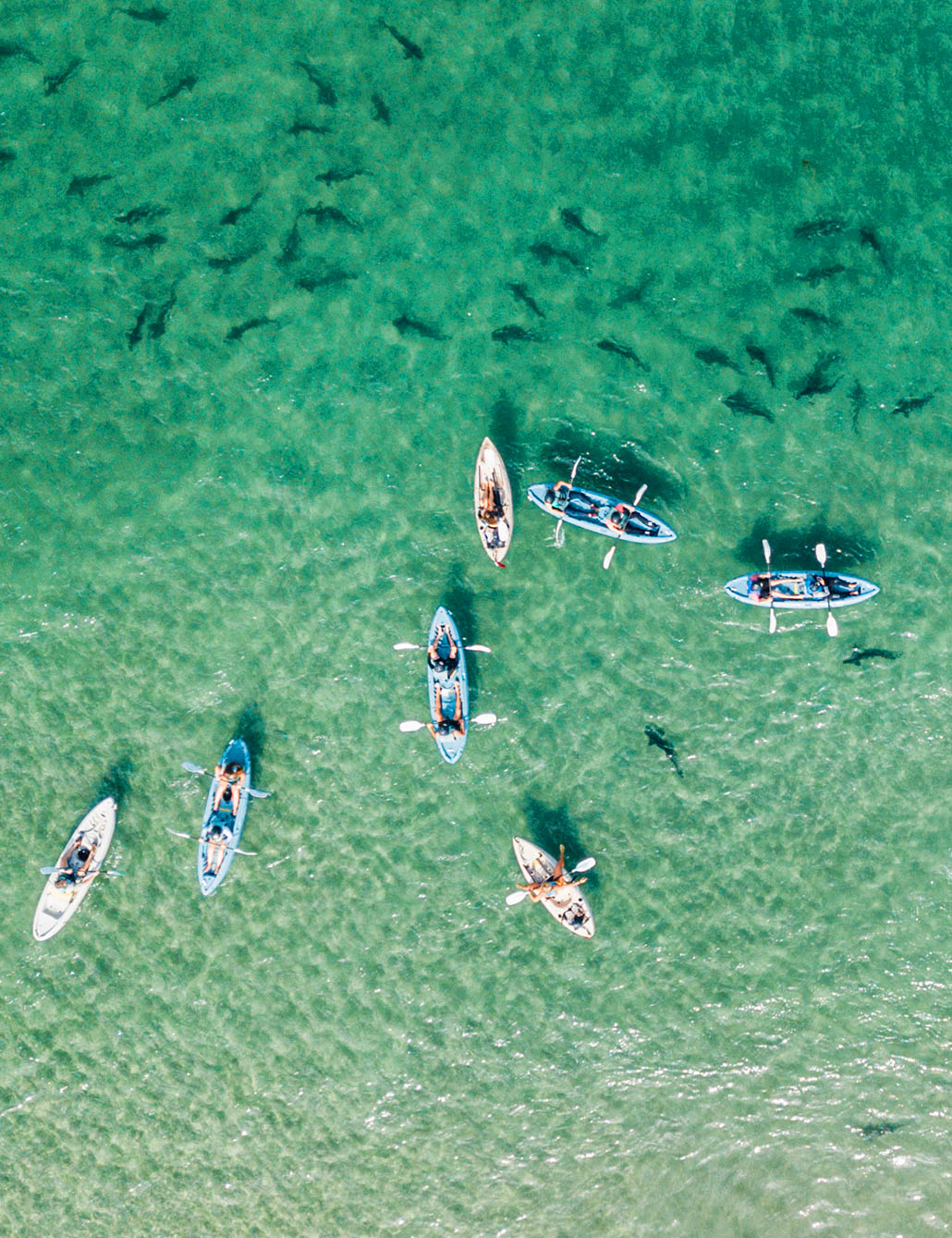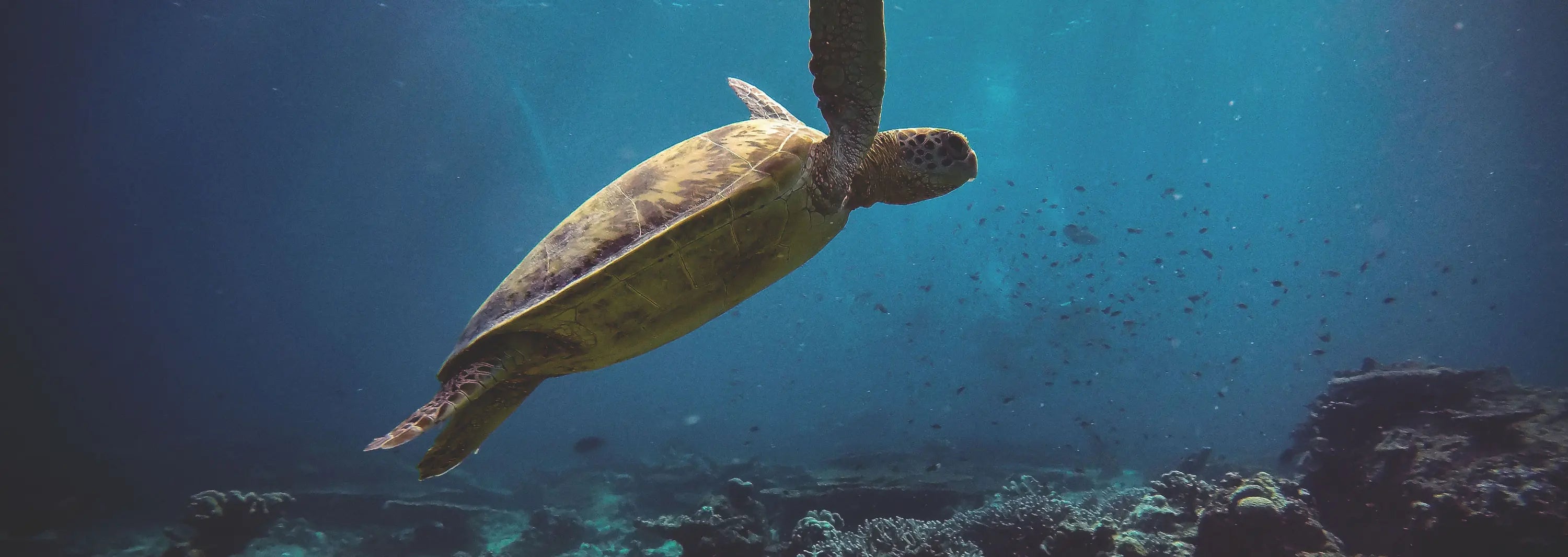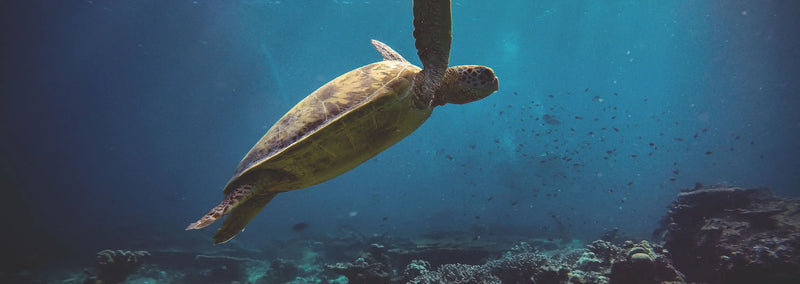La Jolla's Ecological Reserve (recently renamed Matiahuayl State Reserve) was established in 1970 to protect and conserve marine life, associated habitats and ecosystems. The reserve starts at the Seven Sea Caves and extends north to Scripps Pier. This remarkable stretch of water is home to La Jolla's Underwater Park, part of La Jolla's Submarine Canyon, giant kelp forests and rocky reef. The preserve shelters numerous species, including Leopard Sharks, Sea Turtles, Sea Lions, Dolphins and migrating Whales. La Jolla's slowly sloping ocean floor mixed with artificial reefs and kelp forests fosters gentle currents, and great ocean visibility, making La Jolla Shores a world renowned location for an ocean kayak, snorkel or stand up paddle board adventure. Only 2% of the world's ocean water is protected by state and federal law, which also makes La Jolla's ecological reserve a rare place to see undisturbed wildlife in their natural habitat.
La Jolla's Ecological Reserve is arguably the best place to see marine mammals in their natural habitat in all of California. In terms of pure abundance of sea life, the beautiful surrounding landscape and perfect climate means La Jolla is the perfect spot to observe sea life almost any day of the year.
Grey Whales are one of the world’s largest mammals, at a length of 40-50ft, weighing in at 30-40 tons — about the size of a school bus! They are baleen feeders, using teeth made from a material similar to human hair to filter and to allow the smaller organisms to pass into their mouths. The Gray Whales were almost hunted to extinction in the 1800’s for their blubber until the International Whaling Commission banned the hunting of these animals in 1946 and their population has recovered, although not near the pre-whaling amounts.
They spend most of their time feeding off the Alaskan coast, but during the winter months they start the 12,430 miles round-trip to Baja California for mating season. The shallow lagoons in Mexico provide shelter for the mammals while they strengthen the calves for the migration back to the nutrient rich waters in the north.
The Grey Whales follow the Scripps Canyon through the La Jolla Ecological Reserve as a navigation route, kind of like the I-5. The depths of the canyon provide food for the whales as they often use their tail to stir up the sediment for the whales to filter feed off plankton. Grey Whales are a spectacular experience to see on the kayaks, and it’s a non-invasive way to witness these gentle giants swim by. Larger motorized vessels create noise pollution that can disturb these mammals.
Fun Fact: Whale’s milk is rich in fat, helping the calves build up weight for the journey to Alaska. Once the calves are strong enough to make the journey back to Alaska, the migration route becomes closer to shore, making La Jolla a unique location to see these animals up close.
California Sea Lion
The California Sea Lion is one of the most iconic mammals of La Jolla Cove. These marine mammals are playful and have distinct personalities. The sea lions are very social animals, often huddled up on each other on the rocks near the sea caves. They huddle in groups to regulate body temperature. Most can usually be seen sunbathing during the day and hunting throughout the night. The primary diet of the Californian Sea Lion consists of a variety of small fish and squid. The juvenile pups are curious animals, swimming most of day to learn their environment and interacting with kayakers and swimmers.
The females can reach the size of 5.5 ft weighing in at 110-600 pounds while the males are about 7.25 ft ranging from 440-2,200 pounds. The demographic of the sea lions in La Jolla Cove are almost all female, with a few males and one very large alpha, locally known as “Bruno”.
Fun Fact: A group of sea lions is called a raft. California Sea Lions can reach a depth of up to 900 ft, and the deepest recorded dive was 1,760 ft! They are able to perform these dives by slowing their heart rate for diving about 10 minutes.
Harbor Seal
Harbor seals are an endangered species in California and are protected by both state and federal law. In the La Jolla Cove we spot them by the Children’s Pool, sunbathing on the sandy beach or swimming around the area. Their primary diet consists of a variety of small fish and shellfish.
They are often confused with the sea lion, but are different in many ways. The harbor seals are better suited for life in the water, more hydro-dynamic and heavier with smaller flippers. They will sometimes sunbathe on the sandy beach, although you will never see them on the rocks because their bodies cannot climb over the rocks. They do not have ear lobes like the sea lion, but have holes for better hearing underwater.
Fun Fact: The Harbor Seal’s pups are born instinctively knowing how to swim only a few hours after birth!
Common Dolphin
The common dolphin is a frequent visitor in the La Jolla Ecological Reserve. The average size of an adult is about 8 ft at 300 pounds. They are highly social and intelligent animals that swim in pods consisting anywhere from 6 to over 1,000 dolphins!
By utilizing many different vocals, they communicate with other dolphins and use echolocation to discover underwater topography and uncover potential threats. Dolphins use a very complex hierarchy based on a variety of factors such as age and size. The social dynamic of dolphins is seen by their behavior and their playful interactions. Using the highly developed social behavior of the pods, they will herd large schools of fish into tight balls for eating. They’ll typically feed on a variety of different fish and squid here in La Jolla, often seen near our kelp forest and Scripps Canyon during feeding and even closer to the beach for breeding. They will often travel in pods of 8-12 dolphins, occasionally with sea lions tagging along to benefit from the bait balls formed by the pods.
Fun Facts: The common dolphins aren’t a migratory species and live in La Jolla year round, only to swim to other areas when food is sparse, but they will always return home after feeding.
Bottlenose Dolphin
Bottlenose Dolphins are occasionally seen in the waters of La Jolla. Although very similar to the Common Dolphin, there are some striking differences - the most noticeable being the shortened snout.
Echolocation is an amazing attribute to the success of the Bottlenose Dolphin, although it's not believed that there is a specific "dolphin language". With the use of a variety of audible and visual signals, they can communicate effectively. High frequency clicks and squeaking from their nasal passages allow the detection of prey.
Starting from birth, their mother's continually sing to their calves, who learn their mother's voice. At one month old, Bottlenose Dolphins develop a signature whistle distinct from other dolphins, which is used for socializing behavior. The dolphin's pectoral flippers are very similar to a human's hand bone structure, containing all five "fingers" within a flipper.
Green Sea Turtle
Only about 60 Green Sea Turtles are in San Diego. In 1850, these types of turtles were commonly harvested in Mexico and kept in the San Diego bay for consumption. Some of these turtles would escape the confines of their cages and made life here in La Jolla.
Although rare to spot due to their low numbers, Green Sea Turtles thrive in La Jolla under the safety and oversight of this Marine Protected Area. The water in La Jolla is typically too cold to support sea turtles, but they adapted to survive in this environment.
La Jolla's Submarine Canyon brings an upwelling of nutrient-rich water, which in turn encourages phytoplankton to bloom, seaweed to grow, and an abundance of marine fish to make La Jolla their home.
La Jolla Cove is the destination for one of the world’s largest migration of Leopard Sharks. Leopard Sharks are named for the prominent spots on their back. As year round residents of La Jolla, they usually reside in the deeper waters feeding off squid and crustaceans, but in the summer/fall months pregnant females will migrate to the warmer shallow waters in La Jolla Shores. This helps during their gestation period to produce 4 to 33 pups, as the warmer water acts as an incubation for the mothers.
Leopard sharks are very timid creatures and will swim away from noise such as splashing. The best way to view these animals is by snorkeling above them as they swim by.
Fun Fact: The Leopard Sharks can reach lengths of 5 feet, and are completely harmless to humans. They are found all over the globe, but the migration in La Jolla is known to be one of the largest migration of these animals in the world.
Garibaldi
The Garibaldi fish is a common and easily spotted fish in the La Jolla Ecological Reserve, which isn’t surprising, as their bright orange color makes them hard to miss!
Native to rocky reefs around subtropical areas from southern California to Baja, this territorial species feeds on mostly invertebrates that they eat from rocks. Adults maintain a brilliant orange color, while juvenile Garibaldi can be identified by not only their orange coloring, but their bright blue spots that they lose as they grow larger.
As the official marine state fish of California, Garibaldi maintain a protected status and are illegal to spear, and can grow up to 15 in. in length.
Shovelnose Guitarfish
Native to inshore waters and shallow estuaries, the Shovelnose Guitarfish thrive in ecosystems where sandy, muddy sea floors and small crustaceans to feed on are abundant.
Sometimes mistaken for stingrays or bay rays due to their wide body disc (named aptly after a guitar) and tendency to lay partially buried beneath the sand, these harmless bottom feeders forage for food such as worms, clams, crab and shrimp. Their respiratory system, which consists of holes (spiracles) on the top of their heads, make it easy for the Shovelnose Guitarfish to breathe while hiding beneath the ocean floor, waiting for their next meal to wander by.
Bat Ray
Bat Rays typically begin visiting La Jolla in May and can be found around the sandy flats, kelp beds or rocky bottomed shoreline of the Underwater Park. A large bat ray can grow to have a wingspan of almost 6 feet and weight 200 lbs, although most are significantly smaller and weight around 30 lbs.
Bat Rays feed on mollusks, crustaceans and small fish by using their fins to expose prey. Bat Rays, like other stingrays, have a venomous spine in their tail but only use this defense mechanism if they feel threatened.
The abundance of marine life and protective cliffs makes La Jolla home to some pretty cool marine birds.
Cormorant
As the expert swimmer, the Cormorant is a unique aviator in La Jolla. They have a dense bone structure that makes them awkward at flying, which they often do very low to the water's surface. They'll dive down to depths of 100 meters to catch prey such as mackerel and sardines. Cormorants often build their nests on the cliffs near the Seven Sea Caves, as the hard limestone provides a solid foundation for raising hatchlings.







